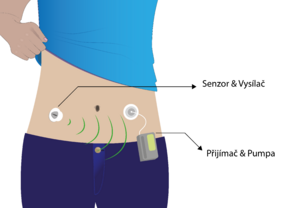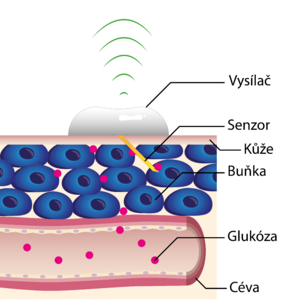Continuous glucose monitoring
Continuous glucose monitoring is a method of measuring the development of blood glucose levels (glycemia) throughout the day (24 hours).This technology significantly improves the treatment options and quality of life of patients, especially with type 1 DM . In recent years, it has been developing rapidly - measuring accuracy is improving, and the size of sensors and invasiveness are decreasing.
Basic System Description[edit | edit source]
- The CGM system has three basic parts
- Sensor - continuously measures blood glucose in the interstitial fluid at intervals of about 1-5 minutes (glycemic delay vs. glucose concentration in the interstitial fluid is about 4-10 minutes - depends, for example, on blood circulation, temperature).
- Transmitter - must be as light as possible (patch peeling off, problem with sagging skin) and as small as possible (so as not to interfere).
- Receiver.
The wire electrode coated with the enzyme layer and the protective layer is permanently inserted into the subcutaneous tissue at an angle of 45 ° or 90 °. The measurement is based on the electrochemical principle, ie the glucose oxidase method. The system must be calibrated to SMBG (preferably at stable glycemia). The service life of the electrode varies from 7 to 30 days depending on its biocompatibility. Of the whole system, the electrode is the most demanding part for production, prices are around 1000 to 1700 CZK. The transmitter can be purchased for CZK 10,000 and the receiver for CZK 13,000.
Advantages[edit | edit source]
- CGM has the following advantages over traditional glucometer (SMBG) measurements
- Trend monitoring - glycemic response to various situations, prediction of hyperglycemia and hypoglycemia, detects 4 times more severe fluctuations in glucose levels than measured by glucometer (SMBG).,
- Alarms (hyperglycemia, hypoglycemia).
- Possibility to enter parameters such as the amount of carbohydrates, the number of units of insulin applied , physical activity, illness.
- The measurement is very accurate - the treatment can be adjusted based on it.
- CGM can reduce glycated hemoglobin (HbA1c) by up to 1% compared to SMBG.
- CGM can be appreciated by
- Parents - do not have to check on the child during the night.
- Athletes and students - can focus more on the match or the test.
- People with hard work - better planning of daily activities.
- Pregnant women and women contemplating pregnancy.
Disadvantages[edit | edit source]
- Security risk: There is a risk of eavesdropping or data tampering. Manufacturers are afraid to connect the system to a mobile phone (risk on the Internet).
- Measurement accuracy, eg in case of incorrect calibration - the patient does not make sure that the measurement is correct with a glucometer.
- Memory check - data is overwritten after a few weeks.
- Expired sensors.
- Battery problems (discharging).
- Receiver out of signal range.
- Application in the wrong places.
- Patch allergy.
- Skin irritation (more in the article Non-invasive blood glucose measurement).
- Infection (disinfection required before applying the sensor).
Examples of devices for continuous measurement of blood glucose[edit | edit source]
MINIMED™ (Medtronic)[edit | edit source]
A clear advantage of Medtronic is the possibility of connection to an insulin pump. Medtronic CareLink software allows physician to share CGM data.
Dexcom®[edit | edit source]
The most common is the Dexcom G4 model . Progress and statistics can be viewed in Dexcom Studio (for Windows). In the USA, the Dexcom G5 is used , which can work without a receiver - via BlueTooth , data can be sent to a mobile phone - aimed primarily at parents of children with type 1 DM ( Dexcom share ).
[edit | edit source]
It is not available in the Czech Republic, it has the largest transmitter..
FreeStyle Libre® (Abbott)[edit | edit source]
The manufacturer does not refer to it as CGM, but as an instant glucose measurement system . It is available in the Czech Republic, it is calibrated directly from the factory. Blood glucose is measured every 5 minutes, the measured values are stored in memory for 8 hours. Readings can also be made with a mobile phone with NFC. The manufacturer is currently preparing a sensor with Bluetooth.
References[edit | edit source]
Related Articles[edit | edit source]
- Glycemia
- Selfmonitoring of glycemia
- Intermittent starvation in diabetes prevention and therapy
- Hypoglycemic coma
- Diabetes mellitus
- Type 1 diabetes mellitus (endocrinology) • Type 1 diabetes mellitus (biochemistry)
- Type 2 diabetes mellitus (endocrinology) • Type 2 diabetes mellitus (biochemistry)
- Diabetic education
- Insulin
Sources[edit | edit source]
- ANNA HOLUBOVÁ, . Měření glykémie v praxi [lecture for subject Pokročilé technologie v diabetologii, specialization Všeobecné lékařství, 1.LF UK]. Praha. 12.10.2016. Avaliable from <http://www.albertov.cz/wp-content/uploads/2018/03/měření-glykémie-v-praxi.pdf>.
- MUŽÍK JAN, . Technologie pro měření glykémie [lecture for subject Pokročilé technologie v diabetologii, specialization Všeobecné lékařství, 1.LF UK]. Praha. 10/2016. Avaliable from <http://www.albertov.cz/wp-content/uploads/2018/03/technologie-por-měření-glykémie.pdf>.



